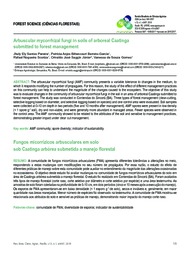Arbuscular mycorrhizal fungi in soils of arboreal Caatinga submitted to forest management.
Arbuscular mycorrhizal fungi in soils of arboreal Caatinga submitted to forest management.
Author(s): PEREIRA, J. E. S.; GARCIA, P. A. B. B.; SCORIZA, R. N.; SAGGIN JUNIOR, O. J.; GOMES, V. de S.
Summary: The arbuscular mycorrhizal fungi (AMF) community presents a variable tolerance to changes in the medium, to which it responds modifying the number of propagules. For this reason, the study of the effect of different management practices on this community can help to understand the magnitude of the changes caused to the ecosystem. The objective of this study was to evaluate changes in the community of arbuscular mycorrhizal fungi in the soil in an area of arboreal Caatinga bmitted to forest management. The study was conducted in Contendas do Sincorá (BA). Three types of forest management (clear-cutting, selective logging based on diameter, and selective logging based on species) and one control area were evaluated. Soil samples were collected at 0-10 cm depth in two periods (five and 10 months after management). AMF spores were present in low density (< 1 spore g-1 soil), dry and non-viable, and were generally more abundant in managed areas. Fewer species were observed in the control area. The AMF community showed to be related to the attributes of the soil and sensitive to management practices, demonstrating greater impact under clear cut management.
Publication year: 2018
Types of publication: Journal article
Unit: Embrapa Agrobiology
Keywords: Community, Indicator of sustainability, Spore diversity
Observation
Some of Embrapa's publications are published as ePub files. To read them, use or download one of the following free software options to your computer or mobile device. Android: Google Play Books; IOS: iBooks; Windows and Linux: Calibre.
Access other publications
Access the Agricultural Research Database (BDPA) to consult Embrapa's full library collection and records.
Visit Embrapa Bookstore to purchase books and other publications sold by Embrapa.

